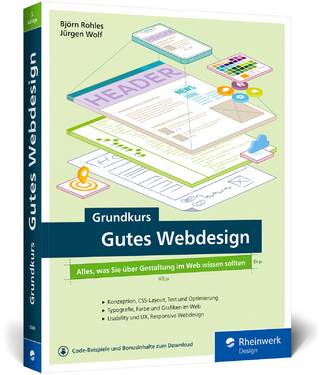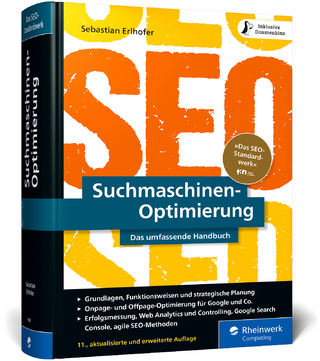
Microsoft Expression Web 4 In Depth
Que Corporation,U.S. (Verlag)
978-0-7897-4919-2 (ISBN)
- Titel ist leider vergriffen;
keine Neuauflage - Artikel merken
This is the world’s most expert, complete, and practical guide to succeeding with Expression Web 4 SP2! Microsoft insider Jim Cheshire presents today’s best solutions for everything you need to do with Expression Web 4 SP2 and its brand-new HTML5, CSS3, and jQuery tools!. Create, edit, and manage content… implement leading-edge designs… integrate dynamic content… add powerful features with no custom coding… leverage SP2’s latest time-saving features…do the job right, and do it fast!
“In the trenches” solutions, big-picture insights, real examples, time-saving shortcuts
Boost productivity with custom workspaces, Snapshot & Snippet panels, Universal
Commenting, and other SP2 improvements
Optimize every phase of development, from site creation through reporting
Use Expression Web 4 features together to solve real web design problems
and achieve real business goals
Build HTML5/CSS3 standards-compliant sites that work properly in any modern browser
Learn high-efficiency techniques for using tables, forms, and QuickTags
Add more dynamic, interactive content with Behaviors and Layers
Differentiate your site with dynamic components and client-side JavaScript
Use ASP.NET’s simple tools to display, edit, and manage data without custom code
Develop accessible, Section 508- or WCAG-compliant sites
Efficiently test sites and apps with SP2’s enhanced SuperPreview and remote browsing
Easily password-protect content with ASP.NET Login controls and membership features
Leverage Expression Web’s updated PHP 5.3 support, including module IntelliSense
and “Open as PHP”
Efficiently troubleshoot any site development problem
Register your book at www.quepublishing.com/title/9780789749192 to get the entire book in searchable PDF format, including all examples and sample files, plus a bonus four-chapter mini book on creating add-ins with JavaScript and HTML!
Jim Cheshire is the owner of Jimco Software and Books and is the author of several design books and books on the Amazon Kindle and Barnes and Noble Nook. In his real job, Jim works as a senior escalation engineer at Microsoft on the ASP.NET, IIS, and Expression Web teams. He has worked on the FrontPage, Visual Basic, ASP, IIS, and ASP.NET teams at Microsoft for almost 15 years. You can reach Jim by visiting one of his websites: www.jimcobooks.com or www.jimcosoftware.com. You can also email him at jwc@jimcobooks.com.
Introduction
Who Should Use This Book? 1
Why Use Expression Web? 1
How This Book Is Organized 2
Special Elements 3
I An Overview
1 An Overview of Expression Web 4 5
The Expression Web Interface 5
Panels 5
The Folder List 7
The Design Surface 8
The Status Bar 9
Working with Sites 9
Creating Sites 9
Site Reports 10
Publishing Sites 10
Tools for Creating Pages 11
Dynamic Web Templates 11
Find and Replace 11
Editing Tag Properties 12
Quick Tag Tools 13
Powerful CSS Tools 13
Style Builder 13
Manage Styles Panel 14
Apply Styles Panel 14
Site Optimization 16
Accessibility Checker 16
Compatibility Checker 16
SEO Checker 17
SuperPreview 17
CSS Reports 17
Scripting and Dynamic Content 18
Interactive Buttons 19
Behaviors 19
Layers 19
Photoshop Content 21
Deep Zoom Images 21
Video 21
ASP.NET Controls 22
PHP Support 22
Data Access Features 23
Creating Add-Ins 23
II Creating Content in Expression Web 4
2 Creating, Opening, and Importing Sites 25
What Is a Site? 25
How Expression Web Maintains a Site 25
Sites and Subsites 27
Site Templates 27
Types of Sites 29
Disk-Based Sites 29
FTP Sites 32
HTTP Sites 35
Importing Sites with the Import Site Wizard 38
Choosing an Import Method 38
Specifying a Destination Web Location 44
Finishing the Site Import Process 44
Deciding on a Site Type 45
3 Creating Pages and Basic Page Editing 47
Creating Pages 47
General Page 47
ASP.NET Pages 49
CSS Layouts 50
Style Sheets 50
Frames Pages 51
Importing Files 51
Formatting Text 52
How Expression Web Formats Text 52
Font Families 54
Font Sizes 55
Creating Hyperlinks 55
Targeting Hyperlinks 56
Hyperlink Parameters 56
HTML Bookmarks 57
Hyperlink Screentips 58
Spell-Checking 59
Configuring Page Properties 60
General Tab 60
Formatting Tab 61
Advanced Tab 61
Custom Tab 62
Language Tab 63
Using Code Snippets 63
Configuring File Editors 65
Making the Most of Code Snippets 68
4 Using Page Views 69
Introduction to Page Views 69
Working in Design View 70
Visual Aids 70
Ruler and Grid 74
Tracing Images 76
Adjusting Page Size 78
Working in Code View 79
Customizing Code Formatting 81
Quick Tag Tools 83
IntelliSense 83
Context Menu 84
Bookmarks 84
Working in Split View 85
Taking Advantage of Page Views 86
5 Using Tables 87
The Origin of Tables 87
The Makeup of an HTML Table Tag 88
The align Attribute 88
Table Borders 90
The cellpadding Attribute 91
The cellspacing Attribute 92
The frame Attribute 93
Rows, Columns, and Cells 93
The colspan and rowspan Attributes 94
Aligning Content in Cells 95
middle 95
Tables in Expression Web 96
Inserting Tables 97
Customizing Tables 97
Designing for Multiple Resolutions Using Tables 106
6 Using Frames 109
Using Frames in Sites 109
When to Use Frames 109
When Not to Use Frames 110
Creating Frames Pages 110
Configuring Frames 112
Splitting Frames 113
Deleting Frames 114
Creating Alternative Content 114
Targeting Frames 115
Adding and Configuring Inline Frames 117
Tips for Frames 119
Frame Borders 119
Resizable Frames 120
Breaking Out of a Frameset 121
7 Editing Tag Properties 123
An Introduction to Tag Properties 123
Understanding the Tag Properties Panel 123
Viewing Tag Properties with the Tag Properties Panel 126
Setting Tag Attributes with the Tag Properties Panel 128
Creating a Page 128
Setting Tag Properties 128
Using Events with the Tag Properties Panel 130
Tag Properties and Web Standards 131
8 Using the Quick Tag Tools 133
Introduction to the Quick Tag Tools 133
Locating and Selecting Elements Using the Quick Tag Selector 134
Editing Page Content Using the Quick Tag Editor 136
Editing a Tag 137
Removing a Tag 138
Inserting HTML 140
Wrapping a Tag 141
Controlling Positioning 142
Editing Tag Properties 142
When to Use the Quick Tag Editor 142
9 Using Graphics and Multimedia 145
Web Image Formats 145
The GIF Format 145
The JPEG Format 146
The PNG Format 146
Inserting Images 146
Formatting Images 148
Resizing Images 148
Changing Picture Properties 149
Converting Images 151
Creating Image Thumbnails 153
Configuring Auto Thumbnails 155
Creating Image Maps 156
Inserting Multimedia 157
Inserting Flash Movies 157
Inserting Silverlight Applications 159
Inserting Silverlight Video 160
Inserting Deep Zoom Images 161
Inserting Windows Media 163
Importing Adobe Photoshop Files 167
Page Transitions 168
Serving Video 169
10 Using Find and Replace 171
An Introduction to Find and Replace 171
Finding and Replacing Text 172
Using Regular Expressions 172
Finding Text 173
Replacing Text 176
Using HTML Rules in Find and Replace 179
Finding and Replacing HTML Tags 181
Saving Queries 182
Editing and Removing Recent Searches 183
11 Configuring Page Editor Options 187
Accessing Page Editor Options 187
Exploring Page Editor Options 187
The General Tab 187
AutoThumbnail Tab 191
Default Fonts Tab 191
Code Formatting Tab 191
CSS Tab 191
Color Coding Tab 193
Authoring Tab 193
Picture Tab 195
Code Snippets Tab 195
Ruler and Grid Tab 195
IntelliSense Tab 197
Font Families Tab 197
Experiment to Learn More 199
12 Maintaining Compatibility and Accessibility 201
An Introduction to Accessibility 201
Designing for Accessibility 202
Accessible Hyperlinks 202
Accessible Tables 203
Accessible Frames 204
Other Accessibility Considerations 204
Using the Accessibility Checker 205
Checking Accessibility 205
Working with the Accessibility Panel 206
Generating Accessibility Reports 208
Designing for Compatibility 209
What Is Browser Compatibility? 209
Compatibility Features in Expression Web 210
Identifying Code Problems 210
Marking Invalid Code 213
Using Reports to Find Problems 214
Seeing Color 216
13 Using SuperPreview 217
An Overview of SuperPreview 217
SuperPreview 217
How SuperPreview Generates a Preview 218
The SuperPreview Interface 220
Pointer Modes 220
DOM Highlighting 220
UI Helpers 220
Layout Modes 221
Preview URL 221
Baseline and Comparison Browser Selectors 222
DOM Tab 222
Browser Size Drop-Down 224
Using SuperPreview to Preview Layout 224
Setting Up the Previews 224
Generating Previews 225
Fixing Rendering Problems 225
Using the Snapshot Panel 229
Using Remote Browsers 230
Building Layouts with SuperPreview 232
III Publishing and Managing Websites
14 Publishing a Site 235
What Is Publishing? 235
Server Options for Publishing 236
FTP 236
FrontPage Server Extensions 237
WebDAV 239
File System 240
Publishing Content 241
Configuring a Publishing Destination and Publishing a Site 241
Publishing Selected Files and Synchronizing Files 244
Optimizing HTML During Publishing 244
Troubleshooting HTTP Publishing 246
Hosting Your Site 253
15 Site Management and Reporting 255
Site Settings 255
General Tab 255
Preview Tab 256
Advanced Tab 257
Publishing Tab 258
Site Reports 259
Configuring Reports 261
Saving Reports 263
Using SEO Reports to Increase Traffic 263
16 Using Personal Web Packages 267
What Are Web Packages? 267
Creating a Web Package 267
Importing a Web Package 270
Capitalizing on Web Packages 272
IV Using CSS in Expression Web 4
17 Creating Style Sheets 273
An Introduction to CSS 273
The Purpose of CSS 274
How CSS Is Applied to Pages 277
External Style Sheets 277
Embedded Style Sheets 277
Inline Styles 278
Formatting Content with CSS 278
Positioning Content with CSS 284
CSS Classes 287
Basic Application of a CSS Class 287
Applying Multiple CSS Classes 289
Pseudo-Classes 290
Pseudo-Elements
| Erscheint lt. Verlag | 19.7.2012 |
|---|---|
| Sprache | englisch |
| Maße | 179 x 230 mm |
| Gewicht | 996 g |
| Themenwelt | Informatik ► Web / Internet ► Web Design / Usability |
| ISBN-10 | 0-7897-4919-X / 078974919X |
| ISBN-13 | 978-0-7897-4919-2 / 9780789749192 |
| Zustand | Neuware |
| Haben Sie eine Frage zum Produkt? |
aus dem Bereich


